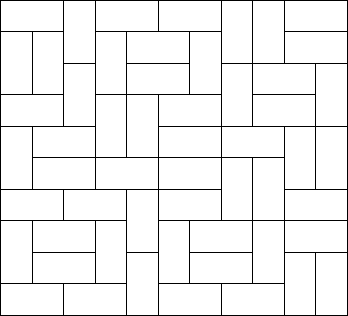Mondriaan's Dream
| Time Limit: 3000MS | Memory Limit: 65536K | |
| Total Submissions: 15207 | Accepted: 8771 |
Description
Squares and rectangles fascinated the famous Dutch painter Piet Mondriaan. One night, after producing the drawings in his 'toilet series' (where he had to use his toilet paper to draw on, for all of his paper was filled with squares and rectangles), he dreamt of filling a large rectangle with small rectangles of width 2 and height 1 in varying ways.

Expert as he was in this material, he saw at a glance that he'll need a computer to calculate the number of ways to fill the large rectangle whose dimensions were integer values, as well. Help him, so that his dream won't turn into a nightmare!

Expert as he was in this material, he saw at a glance that he'll need a computer to calculate the number of ways to fill the large rectangle whose dimensions were integer values, as well. Help him, so that his dream won't turn into a nightmare!
Input
The input contains several test cases. Each test case is made up of two integer numbers: the height h and the width w of the large rectangle. Input is terminated by h=w=0. Otherwise, 1<=h,w<=11.
Output
 For each test case, output the number of different ways the given rectangle can be filled with small rectangles of size 2 times 1. Assume the given large rectangle is oriented, i.e. count symmetrical tilings multiple times.
For each test case, output the number of different ways the given rectangle can be filled with small rectangles of size 2 times 1. Assume the given large rectangle is oriented, i.e. count symmetrical tilings multiple times.
Sample Input
1 2
1 3
1 4
2 2
2 3
2 4
2 11
4 11
0 0
Sample Output
1
0
1
2
3
5
144
51205
题意:用1*2的砖块去铺满一个n*m的矩形的方案数
思路:算是最基本的轮廓线dp的题目。砖块只有横着放和竖着放两种状态。
首先当我们试图去填砖块(i,j)的时候,所有砖块(i1,j1),当其在(i,j)的左上方的时候,应该是已经被填好了的。
这样我们从(n-1)到0和(m-1)到0区遍历的话,就没有后效性的问题了。
所谓的轮廓线dp,是因为dp时的状态代表的是每一行没有填的最上方的砖块,一共m个。也就是相当于已经填好的砖块的轮廓。
然后枚举轮廓线状态去转移就好。
关于一些集合的运算可以去看看这篇博客。http://blog.youkuaiyun.com/say_c_box/article/details/52094549
<span style="font-size:14px;">#include<cstdio>
#include<cstring>
#include <string>
#include <iostream>
#include <algorithm>
#include <vector>
#include <map>
#include <set>
using namespace std;
#define MAXN 200010
#define INF 1000000000
int d1[MAXN],d2[MAXN];
int h[MAXN];
int head[MAXN];
int p[MAXN];
set <int> s;
vector <int> ans;
struct edge{int v;int next;};
edge G[MAXN*2];
int num=0;
int vis[MAXN];
void add(int u,int v){G[num].v=v;G[num].next=head[u];head[u]=num++;};
void dfs(int u,int d[])
{
vis[u]=true;
for(int k=head[u];k!=-1;k=G[k].next){
int v=G[k].v;
if(!vis[v]){
d[v]=d[u]+1;
dfs(v,d);
}
}
}
int n,m,d;
int main(){
scanf("%d%d%d",&n,&m,&d);
for(int i=0;i<m;i++){
scanf("%d",p+i);
s.insert(p[i]);
}
for(int i=1;i<=n;i++){
if(s.count(i)==0)
ans.push_back(i);
}
memset(head,-1,sizeof(head));
memset(vis,0,sizeof(vis));
for(int i=0;i<n-1;i++){
int a,b;
scanf("%d%d",&a,&b);
add(a,b);
add(b,a);
}
h[1]=0;
dfs(1,h);
int max1=0;
for(int i=0;i<m;i++){
if(h[p[i]]>h[p[max1]])
max1=i;
}
memset(vis,0,sizeof(vis));
d1[p[max1]]=0;
dfs(p[max1],d1);
int max2=0;
for(int i=0;i<m;i++){
if(d1[p[i]]>d1[p[max2]])
max2=i;
}
memset(vis,0,sizeof(vis));
d2[p[max2]]=0;
dfs(p[max2],d2);
int cnt=0;
for(int i=1;i<=n;i++){
if(d1[i]<=d&&d2[i]<=d)
cnt++;
}
printf("%d\n",cnt);
return 0;
}
</span>








 本文介绍了一个经典的轮廓线动态规划问题“Mondriaan's Dream”,使用1*2的砖块填充n*m矩形的所有可能方式。通过遍历每一行未填充的最上方砖块状态来实现DP转移,最终计算出所有可能的填充方案。
本文介绍了一个经典的轮廓线动态规划问题“Mondriaan's Dream”,使用1*2的砖块填充n*m矩形的所有可能方式。通过遍历每一行未填充的最上方砖块状态来实现DP转移,最终计算出所有可能的填充方案。
















 1025
1025

 被折叠的 条评论
为什么被折叠?
被折叠的 条评论
为什么被折叠?








